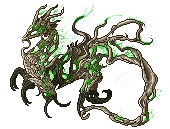Need an account? Register.
 The Balsa Drake
The Balsa Drake
Back to Encyclopedia
The Balsa Drake

70 Clicks

100 Clicks

150 Clicks

Stats
Size:
15.5' Long; 5.5' High
Weight:
435' LBS
Diet:
Nothing
Biome:
Forest, Jungle
Affinity:
Leaf
Family:
Genus:
Balsa Wyrm
Rarity:
Artist Version
Biome:
General Information
Almost all balsa drakes are descended from the same pair, though a few from other bloodlines are known. These two balsa drakes, the founding members of the Deepwoods family, are among the oldest known living creatures in the world. Some people believe balsa drakes to be the superior variety, but there's no evidence for this, as balsa wyrms and balsa drakes are alike except for color and smell. Balsa drakes are largely solitary creatures, so the best way to see one's drake on a regular basis is to train it as a battle companion.<br>(Extra Information by Mathcat)
Egg Information

10 Clicks

20 Clicks

30 Clicks

40 Clicks

50 Clicks

60 Clicks

This egg looks like a root.
Balsa drake eggs are susceptible to wood rot and should be checked daily for softness or discoloration. An overall softening of the shell means the egg will soon start to hatch, but isolated soft spots are often a sign of trouble. The egg is generally out of danger once the green aura has started to form. Balsa drake and balsa wyrm eggs are identical, so unless the parents are known, the only way to be sure which species one has is to wait for the egg to hatch. Balsa drakes leave their eggs behind without a second thought after laying them, so most eggs found in the creche were gathered from the forest by alert travelers.
Baby Information

The root has grown into a small hatchling. A soft glowing aura seems to be coming from it.
Very young balsa drakes are susceptible to a whole host of wood pests. Finding them an amenable companion to keep an eye on them is a must unless one is prepared to carefully check their drake daily for problems. Holly pygmies, leafsprites, and leaf midges are all good choices. Be careful with leafsprites, though, as they sometimes use their magic for mischief and some balsa drakes dislike them. Balsa drakes are never particularly friendly, even when young, and are happiest with calm companions that will let them soak up sunlight in peace.
Teen Information

The hatchling has now grown; its aura glows a bit brighter, and it has started to fly, even though it lacks wings.
Balsa drakes are nearly mature when they start to smell strongly like wood. They will vanish for increasingly long periods of time, often spending days in the forest, but as they're much hardier now, they no longer need to be checked quite so carefully for pests or damage. They can't fly well, but can hover with enough skill to be startling the first time one sees them in the air. Clumsy balsa drakes will sometimes welcome the aid of a friendly windsprite.
Adult Information

Not much is known about Balsa Wyrms, but stories tell of a great entity that brought a single tree to life, twisting and tangling branches and roots to form this creature.
Male balsa drakes smell strongly of redwood, while female balsa drakes smell strongly of pine or eucalyptus, despite looking more like they're made from birch wood. Balsa drakes are generally sturdy individuals, but should still be checked from time to time for splinters, as that can be either an early warning sign of poor health or a sign of excessive aggressive behavior. They also benefit from a gentle pruning from time to time to keep trailing twigs from getting too long, though care should be taken not to cut so much that the cut ends start to bleed sap. The scrap wood contains magic and should be kept for later use or sold. The sap "tears" that balsa drakes produce from the place where their eyes would be are also worth keeping, as the sap has many uses as a spell component.
Extra Info Provided by Mathcat